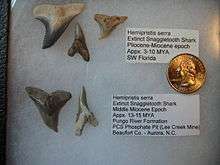Hemipristis
| Hemipristis Temporal range: Middle Eocene–Recent[1] | |
|---|---|
 | |
| Snaggletooth shark (H. elongata) | |
| Scientific classification | |
| Kingdom: | Animalia |
| Phylum: | Chordata |
| Class: | Chondrichthyes |
| Subclass: | Elasmobranchii |
| Order: | Carcharhiniformes |
| Family: | Hemigaleidae |
| Genus: | Hemipristis Agassiz, 1843 |
| Type species | |
| Hemipristis elongata Klunzinger, 1871 | |
Hemipristis is a genus of weasel shark, family Hemigaleidae. It contains one extant species, the snaggletooth shark (H. elongata), as well as several extinct species.
Hemipristis has two distinct type of teeth in each section of its jaw. The ones on the upper jaw act like knives, cutting through the flesh of the prey, while the pointed ones on the bottom act like forks, spearing the prey and holding it down. Because this shark was poorly studied in the past and its top and bottom jaw teeth differ to such a great degree, its top and lower jaw teeth were assigned to a separate genus in the past.
Hemipristis serra

While today's snaggletooth shark is not very large or dangerous, there was another species, Hemipristis serra, which lived in the Atlantic Ocean during the Oligocene and Miocene. This shark was considerably larger than its modern day relative, and had much larger teeth. Marks made by the teeth of H. serra are often found on the bones of the manatee Metaxytherium leading some scientists to hypothesize that H. serra specialized in preying on these sirenians.
The unusual teeth of Hemipristis serra are highly prized by collectors because they are often found in sediments in Southern Florida that yield extremely colorful fossil shark teeth. Their outstandingly large serrations make it a favorite collectible.
Species
- Hemipristis elongata (Klunzinger, 1871)
- Hemipristis curvatus
- Hemipristis serra - An extinct species from the Oligocene-Miocene of Florida, South Carolina, and other areas on the Atlantic coast.
See also
References
- ↑ Sepkoski, Jack (2002). "A compendium of fossil marine animal genera (Chondrichthyes entry)". Bulletins of American Paleontology. 364: 560. Retrieved 2008-01-09.